
Fig.1.Schematic of simple combined cycle plant
Figure 1 shows the schematic of combined cycle power plant. In a combined cycle power plant (CCP) the HRSG represents the interface element between the gas turbine and the steam cycle. Here, the gas turbine exhaust gas is cooled down and the recuperated heat is used to generate steam and the steam thus produced is used to generate electric power. In order to provide better heat recovery in the HRSG more than one pressure level is used. With a single-pressure HRSG about 30% of the total plant output is generated in the steam turbine. A dual-pressure arrangement can increase the power output of the steam cycle by up to 10%, and an additional 3% can result with a triple-pressure cycle [11]. In the literature, different solutions for the increase of the heat recovery efficiency have been proposed. Among these is the well known Kalina cycle, where a mixed working fluid of variable composition is used to provide a better match between the temperatures of the hot and cold streams. An alternative, the use of a fluid with a high critical temperature, such as mercury or potassium, could be interesting for the "bottoming" cycle too [12].
IMPORTANCE OF PINCH AND APPROACH POINTS
Selection of pinch and approach points affects the size of economizer, evaporater and superheater.HRSGs for gas turbine exhaust are usually designed in unfired conditions and the performance evaluated at other unfired or fired conditions for several reasons as mentioned by Ganapathy [13].The reason for this is that two of the important variables which affect the gas and steam temperature profiles, namely the pinch and approach points, cannot be arbitrarily selected in the fired mode. In extracting heat from the flue gas, the ideal is that the flue gas temperature should drop at a constant rate all the way down the duct. This would be simple to arrange if one was trying to heat another gas, or a liquid which did not evaporate as it temperature increased. It would be then easy to keep a constant temperature difference between the flue gas and the fluid being heated at every point. This is not difficult in the economizer and super heater. In economizer water stays as liquid, in superheater it stays as steam. it is impossible to maintain a constant temp difference in the evaporator here as the water passes through the tubing , the water turns to steam, with the temperature staying the same all the way through. Sketch of temperature profile of single pressure heat recovery steam generator is shown in Figure.2.

Fig.2. Temperature profile of single pressure HRSG
The pinch point is the difference between the gas temperature leaving the evaporator and the temperature of saturated steam. Approach point is the difference between the temperature of saturated steam and the temperature of water entering the evaporator. In a heat recovery steam generator the steam production is affected by the conditions of gas turbine inlet temperature and the condition of exhaust gas such as flow rate, temperature and the gas composition entering to heat recovery steam generator. Ambient temperature can significantly affect the approach temperature, as a direct function. As the ambient temperature decreases, the approach temperature will also decrease, indicating that the economizer outlet temperature is getting closer to saturation and the risk of steaming with in the economizer is growing. In general, the pinch will react inversely with ambient temperature. When the inlet conditions to compressor is controlled by some means the ambient temperature will not affect the pinch and approach point
ANALYSIS
A single pressure heat recovery steam generator with a superheater, evaporater, and economiser is considered for the present analysis. The heat recovery steam generator is interface between gas turbine plant and steam turbine plant. The gas and steam temperature profiles are determined by assuming pinch and approach points. The gas flow rate into the heat recovery steam generator, gas inlet temperature to the hrsg, feed water temperature, temperature of steam leaving the superheater, steam pressure, and heat loss in heat recovery steam generator is 2%.To determine gas and steam temperature profiles and steam generation we first assume the pinch and approach points. The values known are gas flow rate (mg), gas temperature at inlet of HRSG (T4), temperature of steam leaving the superheater (Ta), and steam pressure (Ps).Once steam pressure is known, the saturated steam temperature (tsat) at the evaporater is obtained from steam tables. Once pinch point is selected, one can know the temperature of gas leaving the evaporater (T6) and the approach point gives the temperature of water leaving the economiser (Te), since the saturation temperature is known.
In an energy analysis, based on the first law of thermodynamics, all forms of energy are considered to be equivalent. The loss of quality of energy is not taken into account. For example, the change of the quality of thermal energy as it is transformed from a higher to a lower temperature can not be demonstrated in an energy analysis. It shows the energy flow is to be continuous. An exergy analysis, based on the first and second law of thermodynamics, shows the thermodynamic imperfection of a process, including all quality losses of materials and energy. For pinpointing and quantifying the irreversibilities an exergy analysis has to be performed. While doing exergy analysis the following assumptions are made M =650kg/sec, HRSG inlet g temperature=6000C, Pinch Point=200C, Approach Point=50C, temperature of steam = 5500C, pressure loss in H R S G = 0 . 0 5 b a r , h e a t l o s s i n H R S G = 2 % , C =1.147kJ/kgK,R =0.287,T =298K.


Energy balance across evaporater and superheater gives

Superheater energy balance gives

The economizer energy balance gives























RESULTS AND DISCUSSION

Fig.3 Variation of mass flow rate of steam with pinch point for various flow rates of gas
Figure 3 shows the effect of pinch point on mass of steam produced for different gas flow rates. The mass of steam produced is high for low pinch point, because of more heat absorption from the flue gas. For the same pinch point, as the exhaust gas flow rate increases, the mass of steam produced also increases, which results more power output from the steam turbine. Figure 4 shows the steam produced with exhaust gas flow rate for various pinch points with and without heat loss in HRSG. The mass of steam generated increased with gas flow rate and also with decrease in pinch point.

Fig.4.Variation of steam flow rate with gas flow rate for various pinch points

Fig.5.Variation of mass flow rate of steam with approach point
Figure 5 represents the variation of mass flow rate of steam with approach point. When approach point increases the mass flow rate of steam and steam turbine work output decreases, because more amount of heat is required to generate steam and thus decreases the total mass of steam and further it decreases the turbine output. The variations of stack temperature (T7) with pinch and approach points are shown in Figure 6.With increase in pinch point temperatures the stack temperature also increases, because of large temperature difference between gas and steam temperature profiles.

Fig.6.Variation of stack temperature with pinch point

Fig.7.Variation of specific work output with pinch point for various max pressures
Figures 7 represent the specific output change with pinch point for different maximum steam pressures. The mass of steam and turbine work output decreases with increase in pinch point, but for same pinch point, with increase in maximum pressure the mass of steam and turbine work increases. At higher pinch points even the pressure is high the specific work output is decreased.
Figures 7 represent the specific output change with pinch point for different maximum steam pressures. The mass of steam and turbine work output decreases with increase in pinch point, but for same pinch point, with increase in maximum pressure the mass of steam and turbine work increases. At higher pinch points even the pressure is high the specific work output is decreased.

Fig.8.Variation of specific work output with approach point for different max pressures
Figures 8 demonstrate the change in specific work output with approach point for different maximum pressures. With increase in approach point there is decrease in turbine work output. For same approach point with increase in maximum pressure the mass of steam and turbine output increases but after certain approach point at high pressure with increase in approach point the mass of steam and turbine output is decreases compared at low pressure. It is because of less steam generation at high approach temperature.

Fig.9.Effect of mass flow rate of gas on Irreversibilities in HRSG components
Figure 9 shows the variation of irreversibilities in different sections (economiser, evaporater, and superheater) of Heat recovery steam generator (HRSG) with mass flow rate of gas. As the gas mass flow rate increases the irreversibilities also increases because of increase in availability. When gas flow rate is changed from 450kg/sec to 700 kg/sec the mass of steam generated increased from 64.5kg/sec to 100.5 kg/sec.

Fig.10. Effect of HRSG inlet temperature on Irreversibilities in HRSG components
Figure 10 shows the change in irreversibilities with HRSG gas inlet temperature. As the gas temperature increases the availability also increases. HRSG inlet temperature depends on the conditions of gas turbine cycle. The gas turbine inlet temperature is limited because of turbine material considerations .With increase in temperature the irreversibilities in economiser, evaporater increases because of increase in temperature difference between the two fluids. The irreversibility in evaporater follows the same path of superheater, but the total irreversibility decreases because of decrease in irreversibility of exhaust gas.

Fig.11. Effect of pinch point on irreversibilities

Fig.12.Effect of approach point on irreversibilities
Figure11 discussed the change in irreversibilities with pinch point. When the pinch point increases the temperature difference between steam and gas also increased. This causes increase in irreversibility, but in superheater the irreversibility decreases with increase in pinch point. Figure 12 shows the variation of irreversibilities with approach point. As the approach point increases the irreversibilities also increases because of large temperature difference in evaporater.Low approach point results less irreversibilities but increased heat transfer surface area.

Fig.13.Effect of steam pressure on irreversibilities
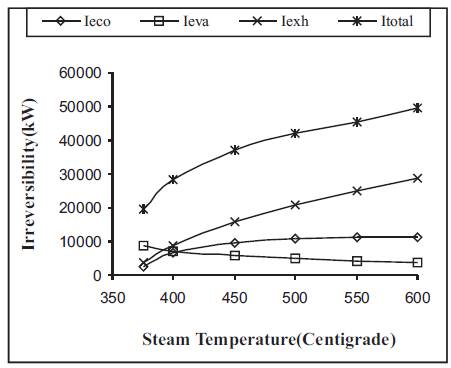
Fig.14.Effect of steam temperature on irreversibilities
Figure 13 discussed the change in irreversibility with steam pressure. The irreversibilities decrease with increase in steam pressure because of increase in saturation temperature of steam and decrease in temperature difference between steam and gas in the heat recovery steam generator. Figure 14 shows the change in irreversibility with steam temperature. As the steam temperature increases the irreversibility in the evaporater decreases because of increase in evaporater gas inlet temperature. With increase in steam temperature the total irreversibility increased because of increase in exhaust gas irreversibility.
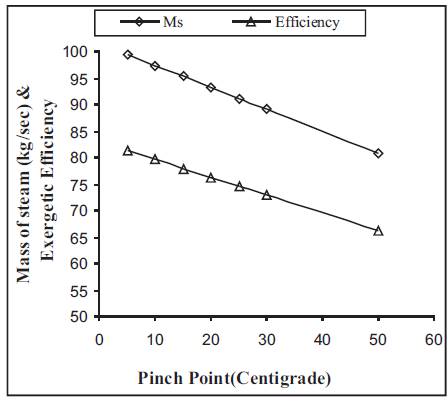
Fig.15.Effect of pinch point on exergetic efficiency
Figure 15 shows the mass of steam generated and exergetic efficiency with pinch point. When the pinch point changed from 50C to 300C, the mass of steam generated decreased from 99.42 kg/sec to 89.1 kg/sec and exergetic efficiency changed from 81.28% to 72.9%. Lower pinch point results high mass flow rate of steam and exergetic efficiency but it requires high heat transfer surface area.
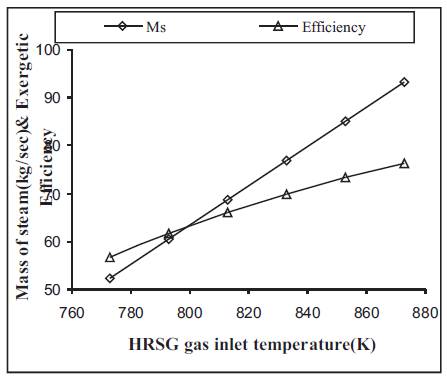
Fig.16.Effect of HRSG inlet temperature on Mass of steam and Exergetic efficiency
Figure 16 shows the variation of mass of steam generated and exergetic efficiency with HRSG gas inlet temperature. When HRSG gas inlet temperature is changed from 773K to 873 K, the mass of steam generated increased from 52.3 kg/sec to 93.2 kg/sec and exergetic efficiency changed from 56.8% to 76.2%.As the flue gas temperature increases the availability also increases which results high work output and causes high exergetic efficiency.
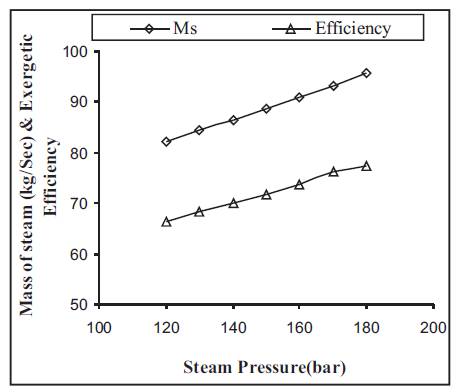
Fig.17.Effect of steam pressure on Exergetic efficiency
Figure 17 shows the change in mass flow rate of steam and exergetic efficiency with steam pressure. As the steam pressure increases from 120bar to 200 bar the mass of steam generated increased from 82.3kg/sec to 101.36 kg/sec, and exergetic efficiency increased from 66.52% to 81.69%.When the steam pressure increases the saturation temperature also increases and latent heat required for vaporization is decreased which results high mass flow rate of steam and increase in work output and exergetic efficiency.
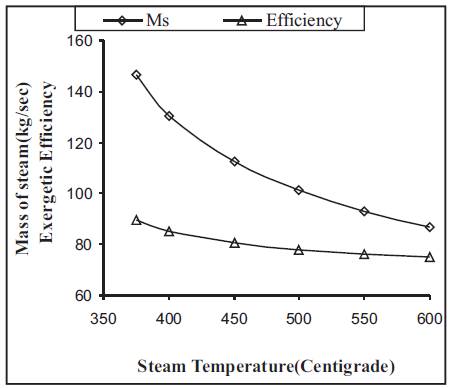
Fig.18.effect of steam temperature on Exergetic efficiency
Figure 18 shows the change in mass of steam generated and exergetic efficiency with steam temperature. The mass of steam generated decreases because large amount of heat is required to get the desired superheat temperature. The exergetic efficiency decreases with steam temperature because of increase in total irreversibility of heat recovery steam generator
Conclusion
Combined cycle power plants play an important role to meet the present energy demand. The heat recovery steam generator (HRSG) forms the backbone of combined cycle power plant. In the present paper performance simulation and exergy analysis of heat recovery steam generator is done. The heat recovery steam generator performance is directly depends on the operating conditions. Pinch point, approach point, gas inlet temperature, and gas flow rate effects the mass of steam produced and power output of steam turbine. With increase in pinch and approach points the stack temperature also increases. Low pinch point results high steam production because of more heat utilization. As the steam pressure increases the efficiency also increases but depending on the material considerations we limit the steam pressure.
In exergy analysis the effect of various parameters like repinch point, approach point, steam pressure, steam temperature, mass flow rate of gas and gas temperature are studied on irreversibilities of different sections in HRSG, loss in exhaust gases, mass of steam generated and exergetic efficiency and came to the following conclusions. (1)Pinch point selection play an important role in hrsg performance, very low pinch point requires large heat transfer surface area and selection of high pinch point reduces the heat transfer. (2)Approach point is selected such that the water enters into the evaporater at less than saturation temperature, if the approach temperature increases the total irreversibility in the HRSG also increased. (3)Selection of steam temperature is such that it should be able to produce more work. At low steam temperature the turbine work output and cycle efficiency is less because of low enthalpy of steam. (4)Steam pressure is selected such that more mass of steam generated. At higher pressures because of low latent heat more steam is generated. (5)Mass flow rate of gas affects the HRSG performance such that, with increase in flow rate of exhaust gas the mass of steam generated and total irreversibility also increases. For each kg of steam generated 5.5 to 8 kgs of exhaust gas is required. (6)HRSG gas inlet temperatures also play an important role in HRSG performance. When the required steam temperature and mass of steam generated is more the gas temperature must be high. If the gas temperature is low we require large flow rate of gas and heat transfer area to get the required steam flow conditions.
NOMENCLATURE
AP = Approach Point,0C
C =Specific heat, kJ/kg K
hl = heat loss in HRSG
h = enthalpy, kJ/kg
I =Irreversibility (kW)
M = mass of gas, kg/s
M = mass of steam, kg/s
PP = Pinch Point, C
P = pressure (bar)
Q = heat absorbed by water and steam, kW
S =entropy (kJ/kgK)
T = Temperature ( C)
SUBSCRIPTS
a =hrsg steam outlet
b = condensor inlet
c =condensor outlet
d =economizer inlet
e =evaporater inlet
g =evaporater exit
net =net output
p =pump
s =steam cycle
st =steam turbin
4, 5, 6, 7…=Temperature of gas at different sections in HRSG